|
|
HEALTHY HAPPENING March 2019
|
What Is Cupping Therapy?
And Why You Might Want to Give It A Try.
By Meagan Coy |
You may have heard of cupping therapy before, but aren’t quite sure exactly what it entails, or what to think of it. The pictures you may have seen of the red welt-like marks from the effects of cupping may have steered your interest away. But I am here to tell you that you need not be afraid; cupping therapy is a very beneficial way to help relieve all sorts of issues with the body such as back, shoulder and hip pain, as well as respiratory issues. It is a treatment deriving from Traditional Chinese Medicine that is gaining more and more popularity in the Western alternative healing world.
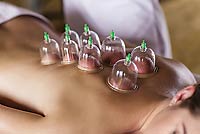 Cupping therapy might seem trendy now, but it’s not new. It dates all the way back to ancient Egyptian, Chinese, and Middle Eastern cultures. It involves attaching rounded inverted cups to certain parts of the body using a vacuum effect, causing it to pull the skin, muscle and fascia, which rises and reddens as your blood vessels expand. Cupping can be divided into two categories: 1. Wet or 2. Dry. In the procedure known as "wet cupping," the skin is punctured prior to treatment, causing blood to flow out of the punctures during the cupping procedure which is thought to clear toxins from the body. Wet cupping is not as common, and I do not use it in my practice. In “dry cupping” techniques, there are different types of cups that can be used, such as: glass cups, which are applied by using heat to create the suction; hard plastic cups with valves on the top that are manually pumped to create the suction; and silicone cups that are manipulated by the practitioner to create the suction. The glass cups and silicone cups can be moved around creating a massage-like effect if the practitioner applies lotion or oil to the area being treated, and/or the cups can be left in one place. The manually pumped plastic cups are used only for stationary purposes and cannot be moved once they are in place. After the cups are in place, they are usually removed after five to ten minutes. During a typical cupping treatment, between three and seven cups are placed on the body at one time. Cupping therapy might seem trendy now, but it’s not new. It dates all the way back to ancient Egyptian, Chinese, and Middle Eastern cultures. It involves attaching rounded inverted cups to certain parts of the body using a vacuum effect, causing it to pull the skin, muscle and fascia, which rises and reddens as your blood vessels expand. Cupping can be divided into two categories: 1. Wet or 2. Dry. In the procedure known as "wet cupping," the skin is punctured prior to treatment, causing blood to flow out of the punctures during the cupping procedure which is thought to clear toxins from the body. Wet cupping is not as common, and I do not use it in my practice. In “dry cupping” techniques, there are different types of cups that can be used, such as: glass cups, which are applied by using heat to create the suction; hard plastic cups with valves on the top that are manually pumped to create the suction; and silicone cups that are manipulated by the practitioner to create the suction. The glass cups and silicone cups can be moved around creating a massage-like effect if the practitioner applies lotion or oil to the area being treated, and/or the cups can be left in one place. The manually pumped plastic cups are used only for stationary purposes and cannot be moved once they are in place. After the cups are in place, they are usually removed after five to ten minutes. During a typical cupping treatment, between three and seven cups are placed on the body at one time.
.jpg) Contrary to what you might think, the suction of the cups does not hurt. In fact, most people find the sensation very pleasant, a sort of release. The suction from the cups provides a negative pressure on the skin, muscles, and fascia which contrasts with the positive pressure of a deep tissue massage and can make it a very soothing experience. The negative pressure from the suction allows new blood to flow into that area of tissue which brings several benefits such as: providing a feeling of relief from physical and emotional tensions; enhancing circulation and the healing process by allowing the removal of toxins and dead cells; warms the skin and softens tissues to regain elasticity; reduces inflammation. Contrary to what you might think, the suction of the cups does not hurt. In fact, most people find the sensation very pleasant, a sort of release. The suction from the cups provides a negative pressure on the skin, muscles, and fascia which contrasts with the positive pressure of a deep tissue massage and can make it a very soothing experience. The negative pressure from the suction allows new blood to flow into that area of tissue which brings several benefits such as: providing a feeling of relief from physical and emotional tensions; enhancing circulation and the healing process by allowing the removal of toxins and dead cells; warms the skin and softens tissues to regain elasticity; reduces inflammation.
As a massage therapist, I like to combine cupping therapy with hands-on massage in the same session. I feel that this combination is beneficial because the cupping increases the blood flow and warms the skin, which makes it easier for the therapist to get into the “knots” in the muscles. Also, once the cups are removed, the skin relays information to the therapist about the underlying tissue. A darker patch on the skin indicates an area of restriction or adhesion in the muscles, and it can help the therapist to pinpoint exactly where to massage. Also, allowing the muscles and fascia to get manipulated through suction from cupping, and get that pressure from hands-on massage, the “knots” or tension seem to release and respond better.
I recommend giving cupping therapy a try, especially if you have pain or tightness happening in the body that just doesn’t seem to go away after using other therapies. Cupping could be just what that area needs to feel better.
Meagan Coy is a Licensed Massage Therapist and Yoga Instructor. She offers cupping therapy through her own practice in Moab, at M.C.’s Healing Arts.
|
The Good, the Bad, and the Ugly:
Skin Cancer in the Old West
by Glen M. Bowen, MD
|
You may be surprised to learn that there are close to 6 million cases of skin cancer per year diagnosed in the United States alone! If you take the next most 8 common cancers, i.e. breast, prostrate, lung, colon, etc. and added them altogether, they would not come close to 6 million cases of skin cancer.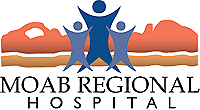
The Good:
The most common of the skin cancers is basal cell carcinoma (BCC) which accounts for about 80% of skin cancers. BCC occurs most commonly in chronically sun exposed areas, namely the head, neck and forearms. Most BCCs are quite subtle to see because they are often the off-white color of paraffin wax and can be hard to spot. Sometimes they will bleed which is a clue to the patient that something is amiss. BCC is the best skin cancer to have since it is very slow growing and behaves much like a herd of cattle in a corral which may push the corral into the prairie but they do not jump the fence and become strays as opposed to the other skin cancers which can leave the skin and infiltrate the lymphatic system (a filter system for the bloodstream). BCCs of the head and neck are usually treated with a technique called Mohs micrographic surgery where the surgeon removes the tumor visible on the skin but before repairing the defect, examines the specimen under the microscope to make sure that all of the root system of the tumor has been removed (much like the tree roots of a tree stump which aren’t visible on the surface). Once the surgeon has confirmed that the roots have been removed, reconstructive surgery is performed to repair the surgical defect left behind from the Mohs surgery.
The Bad:
Squamous cell carcinomas (SCC) are the second most common skin cancers (about 19%) and like BCCs, are most commonly found on the head and neck, backs of the hands, and forearms. They are particularly common on the rims of the ears and the lower lips of men, particularly those who spend a great deal of time out of doors like ranchers, farmers, and river guides. The reason SCCs are considered worse than BCCs is because they have the potential to get into the lymphatic system then into the bloodstream. This is usually in cases where the tumor is been neglected by the patient and the tumors attain a large size (size of a golf ball) or in patients who have had solid organ transplants such as kidneys, heart, or lung and take immunosuppressive medications to prevent graft rejection. Most SCCs are also treated with Mohs micrographic surgery to make sure that all of the tumor roots have been removed before the plastic surgical reconstruction is performed.
The Ugly:
Melanoma is the least common of the three (about 1%) yet is responsible for about 75% of all deaths due to skin cancer. This is why it is considered the ugliest of the skin cancers because it because it is the most deadly. Unlike BCC and SCC, melanoma usually occurs on the torso and the legs (legs are the second most common site in women). These are areas that are usually protected from the sun but tend to get sunburned during vacation. Melanomas are derived from the melanocyte which is the cell in the skin which produces melanin pigment which gives our skin its color. For this reason, most melanomas appear as a mole that is much darker or larger than the other moles. The easiest way to diagnose a melanoma is to apply the “ugly duckling” rule to the lesion. This is to say that most melanomas will look like moles that are very different from the other moles surrounding it and stands out as the ugly duckling stood out from the other ducklings (since it was actually a swan). Melanoma has a high rate of invading the lymphatic system and subsequently getting into the bloodstream and then most commonly travels to the brain, lungs, and liver. Despite its deadly potential, only 1 in 10 people die of melanoma and most will survive them so long as the melanoma is diagnosed and removed early.
Amazingly, Utah has the highest melanoma risk of any state in the United States (we are twice the national average!). It is thought that this might be secondary to our high elevation where there is less ozone to filter out the ultraviolet light that causes most skin cancers (the Colorado plateau was about 1 mile above sea level) and the fact that Utah is fairly far south in latitude; we live at about the same latitude as Rome, Italy. Most Utahans do not have the skin type that allows them to live safely on the Mediterranean Coast. For these two reasons (high altitude and a southern latitude), Utah is a bit of a pressure cooker for creating skin cancer.
In summary, it is a good idea to check all of your skin once a month for any sores that do not heal or ugly duckling type moles which are the best ways of detecting skin cancer as early as possible.
Glen M. Bowen, MD - Professor of Dermatology and Mohs Micrographic Surgery
Huntsman Cancer Institute
University of Utah School of Medicine
Glen Bowen will be speaking on Thursday, March 14th at 7 PM “Protect the Skin You’re In” at Moab Regional Hospital. A light dinner will be served.
RSVP (435) 719-5580 or vista@mrhmoab.org.
|
Regenerative Medicine In Grand and Utah Counties
Access to Care Increases Patient Outcomes
|
It breaks our hearts to see people hobbling around in pain, or trying to avoid raising an arm because it hurts so much. Arthritis, injuries, and other degenerative conditions lead many people to scale back their physical activities. Whether it’s skiing, hiking, rafting, gardening, going for a ride in the car, or key living activities like shopping and cleaning house, joint pains are taking their toll on way too many.
Traditionally, doctors have been limited to providing short-term relief through steroid injections or long-term relief through invasive surgery in the form of joint replacement. Increasingly, steroid injections are falling out of favor, as repeated injections have been found to actually damage treated joints. As a result, patients end up needing joint replacement sooner than they would without the injections. 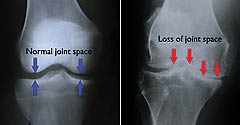
Many patients take anti-inflammatory drugs or even narcotics around the clock to enable them to get through each day. Both approaches are dangerous for a variety of reasons. Of course, no one wants to be dependent on an addictive drug that loses its effectiveness the longer you take it. But the alternative, NSAIDs (ibuprofen, naproxyn, and others), have a number of serious long-term risks, not the least of which include stomach damage and kidney failure.
Unfortunately, too often people feel they have no choice: Either they keep receiving injections, take dangerous drugs, or suffer in constant pain. They recognize that joint replacement is a last-ditch effort. The younger you are, the more likely the surgery will have to be repeated at least once in your life, and the older you are, the more risky the surgery. General anesthesia carries significant risks that only increase with age. And then there’s the long-term recovery and rehabilitation to worry about. 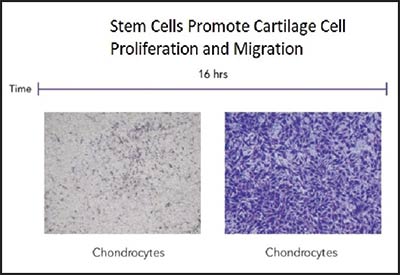
Fortunately, there are now several alternatives to both steroid injections and joint replacement. At Prestige Wellness Institute, we offer the full range of regenerative treatments, including ProlozoneTM, Platelet Rich Plasma (“PRP”), and stem cell therapy. Many patients enjoy permanent relief from pain following one or more Prolozone treatments, with or without PRP. One advantage of these treatments is that, when the damage is caught early enough, a single injection may be all that is needed to keep a person pain-free for years. A second advantage is that, when the damage is more advanced, they can be repeated as often as needed without ever worrying about eroding the joint further, as happens with steroids.
However, those whose joint damage is severe enough to require more than a few such injections will benefit from the latest advancement in tissue regeneration: Stem cell therapy. 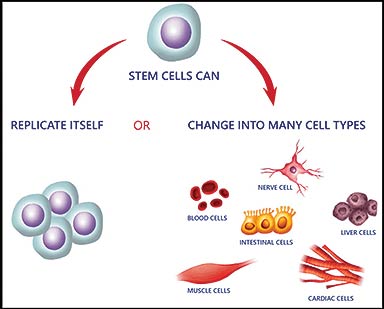
Unlike most cells in the body, stem cells have the unique ability to transform themselves into a variety of different cell types, depending on what is needed. Their job is to heal injured ligaments, tissues, tendons and bones. At Prestige Wellness Institute, we take advantage of this property by injecting concentrated stem cells, growth factors, and signaling molecules into the affected joint to send the signal to your body to initiate the healing process. It’s all natural, with no drug involved. Unlike medicines, which work by blocking the body’s natural processes, stem cells work with the body to restore full function. As a bonus, the treatment is no more painful than a pin prick or a blood draw.
While the healing process continues for a year, pain relief can occur in as little as 48 hours after stem cell injection. No recovery time is required. Concerned about safety? Hundreds of thousands of patients have been treated worldwide with no adverse effects.
“But I saw the x-ray! It’s bone-on-bone!” We hear this over and over. Don’t be fooled. This doesn’t mean you need surgery. Many patients with bone-on-bone joints have been successfully treated with ProlozoneTM, PRP, or stem cell therapy.
Before you go under the knife, hammer, saw, chisel, and drill (no kidding) to have your joint replaced, contact us to find out if a regenerative therapy is right for you. Save the surgery for someone who really needs it.
Prestige Wellness Institute…Helping You Get Your Life Back
*These statements have not been evaluated by the FDA. This product is not intended to diagnose, treat, cure or prevent any disease. This material is provided for informational purposes only and is not medical advice. Always consult a qualified physician before beginning any treatment or therapy program.
|
| |
|
|
|
|
|
|
© 2002-2024 Moab Happenings. All rights
reserved.
Reproduction of information contained in this site is
expressly prohibited.
|
|